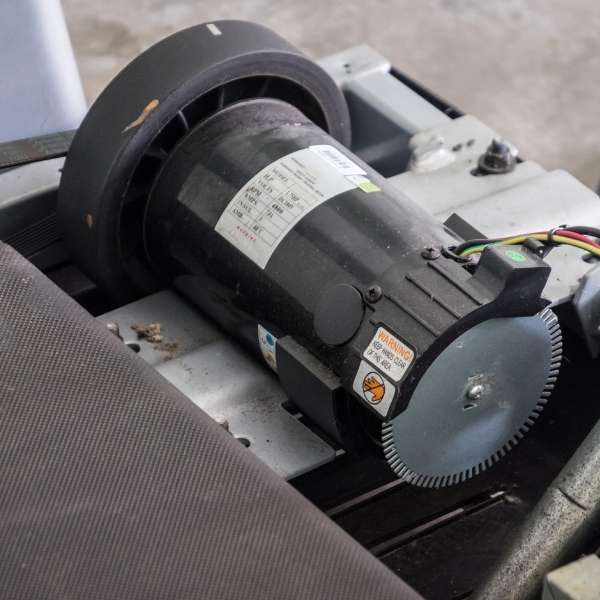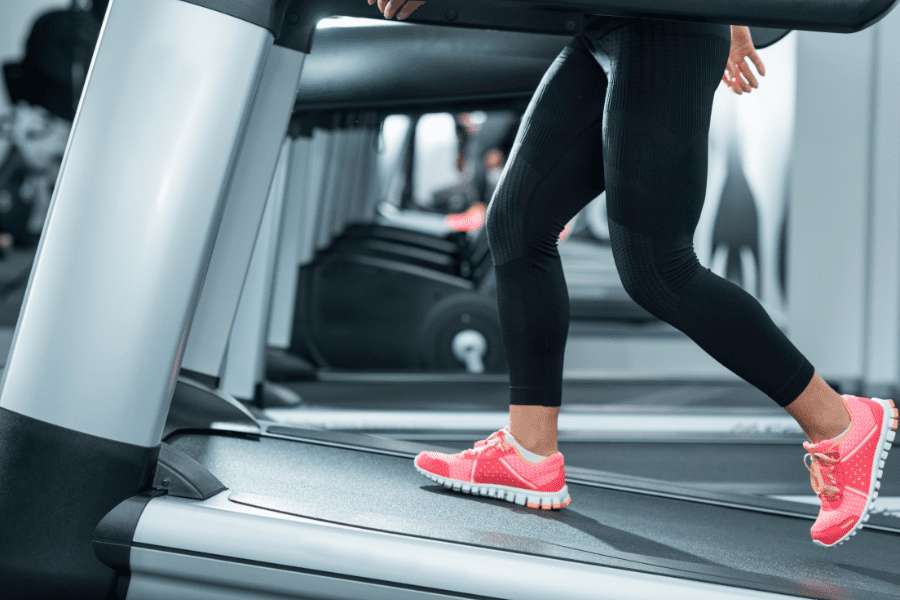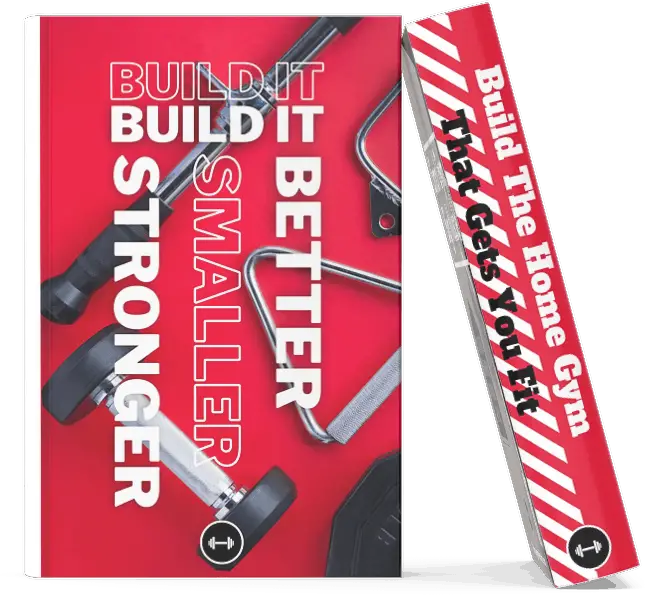Are you wondering if you can carry your treadmill up the stairs or maybe you’re even curious if your floor can hold the weight of a treadmill? I’ve made a list of more than 80 different treadmills and their weights so you can easily find your model or what average weight to expect.
The average home treadmill weighs between 210 and 260 lbs. although some models can be as heavy as 450 lbs. or as light as 100 lbs. Besides size, the biggest factor in weight difference is the motor. A stronger motor is much heavier. Other factors that impact weight are build quality and features.
Of course, treadmills come in different sizes and weights. You probably shouldn’t buy a treadmill based on weight alone. There are some other things to think about. Check out what you have to think about when shopping for a treadmill.
Just want to know which treadmill is perfect for a home gym? Click here to find it.
Contents
How Heavy Are Treadmills?
Not all treadmills are the same so they don’t weigh the same. We’ll get into some averages soon but first, it’s important to understand there are two main types of treadmill.
Most treadmills are motorized, they are by far the most popular. Most manual treadmills are fairly low quality although there are some very cool manual treadmills like the AssaultFitness Runner Pro.
To make it a bit more clear how much you can expect a treadmill to weigh, I’ve split the list up into two types. Manual treadmills are obviously a lot lighter since they don’t have a heavy motor and other electronics.
Motorized Treadmill Weight Chart
| Brand | Model/Series | Treadmill weight | Weight limit |
|---|---|---|---|
| Life Fitness | T3 | 243 | 350 |
| T5 | 341 | 400 | |
| F3 | 264 | 350 | |
| Sole Fitness | F63 | 254 | 325 |
| F80 | 278 | 375 | |
| F85 | 308 | 400 | |
| TT8 | 322 | 400 | |
| F65 | 262 | 350 | |
| S77 | 258 | 400 | |
| Landice | L7 | 345 | 400 |
| L8 | 435 | 500 | |
| BowFlex | 10 | 323 | 400 |
| 22 | 336 | 400 | |
| Nautilus | T616 | 241 | 300 |
| T618 | 253 | 350 | |
| Xterra | TR150 | 97 | 250 |
| TR200 | 99 | 250 | |
| TR300 | 207.2 | 300 | |
| TR6.4 | 209.4 | 325 | |
| TR6.6 | 260.2 | 350 | |
| TRX1000 | 103.6 | 250 | |
| TRX2500 | 207.3 | 300 | |
| TRX3500 | 213.9 | 350 | |
| TRX4500 | 213.9 | 350 | |
| TRX5500 | 223 | 350 | |
| True Fitness | M30 | 220 | 300 |
| M50 | 220 | 300 | |
| Z5.0 | 260 | 400 | |
| Z5.4 | 278 | 400 | |
| Performance 100 | 297 | 350 | |
| Performance 300 | 308 | 350 | |
| Performance 800 | 330 | 350 | |
| 950 | 324 | 350 | |
| Excell 900 | 428 | ||
| 3G | Lite Runner | 152 | 300 |
| 80i | 225 | 325 | |
| Pro Runner | 216 | 350 | |
| Elite Runner | 366 | 400 | |
| LifeSpan | TR1200i | 197 | 300 |
| TR2000e | 211 | 325 | |
| TR2000i | 198 | 350 | |
| TR3000i | 225 | 300 | |
| TR4000i | 239.5 | 350 | |
| TR5500i | 242.5 | 350 | |
| Horizon Fitness | T101 | 180 | 300 |
| T202 | 187 | 325 | |
| T303 | 194 | 325 | |
| 7.0AT | 253 | 325 | |
| 7.4AT | 318 | 350 | |
| 7.8AT | 330 | 375 | |
| Schwinn | 810 | 155 | 275 |
| 830 | 200 | 300 | |
| 870 | 215 | 300 | |
| BodyCraft | T400 | 260 | 425 |
| T800 | 280 | 350 | |
| T1000 | 340 | 475 | |
| NordicTrack | EXP7i | 222 | 300 |
| EXP10i | 229 | 300 | |
| Sunny Health | SF-T7955 | 166.4 | 275 |
| SF-T4400 | 103 | 220 | |
| 7750P | 127 | 220 | |
| SF-T7917 | 148 | 265 | |
| SF-T7857 | 123 | 295 | |
| Proform | Pro 2000 Smart | 262 | 300 |
| Pro 9000 | 263 | 300 | |
| City L6 | 125 | 250 | |
| Carbon T7 | 223 | 300 | |
| Carbon T10 | 223 | 300 | |
| Peleton | Tread | 290 | 300 |
| Tread+ | 455 | 300 | |
| Average | 244.37 | ||
| Min | 97 | ||
| Max | 455 | ||
| Median | 240.25 |
Suggested post: Can you safely put a treadmill upstairs?
Motorized treadmill weights vary significantly, with the lightest being the Sunny Health SF-T4400 at 103 pounds and the heaviest being the Peleton Tread+ at 455 pounds. This range is essential to consider if you plan to move or store your treadmill frequently.
The average weight of a motorized treadmill weighs 244 pounds./110 kg. Most treadmills weigh anywhere from 210 to 260 pounds. However there are also plenty of models that are heavier or lighter than that.
Higher quality and bigger treadmills tend to be heavier although there isn’t a direct correlation between weight and quality. Lightweight models are often small and have underpowered motors.
High-end models tend to be heavier. They have bigger motors, beefier frames, and more electronics which increase the weight. Heavier treadmills tend to also have higher user weight limits because of those stronger frames and motors.
Manual Treadmill Weight table
| Brand | Model | Type | Weight (lbs) | Length (Inch) | Width (Inch) | Height (Inch) |
|---|---|---|---|---|---|---|
| Progear | 190 | Manual folding | 49 | 47 | 23 | 51 |
| Sunny Health | SF-T7723 | Manual | 110 | 59 | 27 | 55 |
| Sunny Health | SF-T1407M | Manual folding | 46 | 49 | 23 | 50 |
| Exerpeutic | 100XL | Manual folding | 73 | 50 | 29 | 50 |
| Condfidence | Manual folding | 47 | 47.2 | 19.1 | 48 | |
| Assault Fitness | Runner Pro | Manual | 280 | 69.7 | 33.1 | 64 |
| Phoenix | 98510 | Manual folding | 45 | 46.5 | 21.1 | 50 |
| Average | 95.7 | 49.8 | 23.7 | 50.7 |
Here you can see that the average weight of a manual treadmill is 95 pounds with most models being between 45 and 50 lbs. The AssaultRunner Pro drags up the average quite a bit. Without that model, the average drops to about 62 pounds.
Manual treadmills can weigh as little as 45 pounds or as much as 280 pounds.
The Sunny Health SF-T7723 is a bit heavier than the average at 110 lbs. It’s also one of the better manual treadmills you can get with a high load limit of 300 lbs. The drawback is that it doesn’t fold up so it takes up a bit more space. The AssaultRunner Pro is by far the best manual treadmill but also comes with a premium pricetag.
Most of the other manual treadmills are very light but they’re not for serious runners. They’re good for walking and light jogging. Their load limits are fairly low and the belt is small. That means larger people and those who want to run will notice a severe lack of space.
Commercial vs. Domestic Treadmill Weights
The treadmills from the list above are domestic models. They aren’t made for use in commercial facilities.
Commercial treadmills are often much heavier and larger with most models ranging from 350 to 500 pounds (159 to 227 kilograms). These treadmills are built to withstand continuous use and abuse by many different people. The frames, motors and components are all built to deal with much more and that makes them heavier (and a lot more expensive).
Unless you’re running for many hours a day on your home treadmill, a domestic model is perfectly fine.
Factors Influencing Treadmill Weight

So the the type of treadmill is one thing that impacts the weight of a treadmill but there are a few other ones that are good to know:
So, in a nutshell, the materials, components, features, and overall design of a treadmill are what make it weigh what it does. Different treadmills serve different purposes, and that’s why you’ll find a variety of weights out there.
Why Treadmill Weight Matters

Why would you care about how much a treadmill weighs in the first place? There are a few good reasons to think about this. The weight of a treadmill can actually impact quite a few things:
The weight of a treadmill is a factor you should look at when buying a treadmill. It’s a proxy for getting an idea of the feel and quality of the treadmill. On the other hand, you also have to make sure you can get it into the right spot and a really heavy treadmill is just harder to move.
Treadmill Weight Vs. Weight Limit
Besides knowing what a treadmill weighs, it’s also good to know what the weight limit of a treadmill is. Loading a treadmill heavier than recommended can wear and burn out the motor quicker than it should. That means you should check the weight limit of a treadmill before you buy to see if it’s suitable for you.
Suggested: Is 30 minutes on a treadmill enough to see results?
The frame, deck, rails, and motor are all built to support a certain weight. Sure, there will be some safety margins but do you want to test them? Also, some cheaper brands tend to overstate their load limits to make their treadmill look higher quality than it actually is.
Besides the official load limit of a treadmill, the motor is an important part to look at. Walking or running puts stress on the motor. The heavier you are, the more stress the motor has to deal with. Having a motor that can put out more power is less likely to be overloaded.
For manual treadmills, the motor isn’t important since there isn’t one.
Here is a table with the weight limits and motor strengths of different popular models.
Popular motorized treadmill weight limit
| Brand | Model | Type | Weight limit (lbs) | Motor |
|---|---|---|---|---|
| NordicTrack | T6.5S | Motorized | 300 | 2.6 Hp |
| Xterra | TR150 | Folding Motorized | 250 | 2.25 Hp |
| Xterra | TRX2500 | Folding Motorized | 300 | 2.25Hp |
| Xterra | TRX4500 | Folding Motorized | 350 | 3.25 Hp |
| Merax | Folding Motorized | 240 | 1.5HP | |
| SereneLife | SLFTRD18 | Folding Motorized | 265 | 1 HP |
| ProForm | 505 CST | Folding Motorized | 325 | 2.5HP |
| Nautilus | T616 | Folding Motorized | 350 | 3 HP |
| Nautilus | T618 | Folding Motorized | 350 | 3.5 HP |
| Average | 303 |
Here you can see that the average weight limit of a motorized treadmill is about 300 lbs. The lowest weight limit is 240 lbs. while the highest is 350 lbs. You can also see that the treadmills with the higher load limits, tend to have stronger motors as well.
Popular manual treadmill weight limit
| Brand | Model | Type | Weight limit (lbs) |
|---|---|---|---|
| Progear | 190 | Manual folding | 230 |
| Sunny Health | SF-T7723 | Manual | 300 |
| Sunny Health | SF-T1407M | Manual folding | 220 |
| Exerpeutic | 100XL | Manual folding | 325 |
| Condfidence | Manual folding | 220 | |
| Phoenix | 98510 | Manual folding | 250 |
| Average | 257.5 |
The average load limit of manual treadmills is a lot lower than motorized ones at 258 lbs. Most models offer a weight limit of 200 to 250 lbs. The treadmills with a higher load limit are heavier as well. This indicates that a heavier and stronger frame is necessary for higher load limits.



